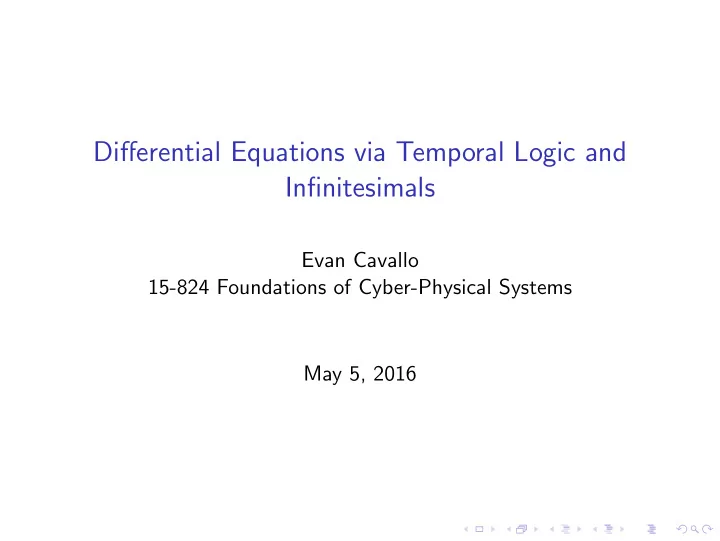

Differential Equations via Temporal Logic and Infinitesimals Evan Cavallo 15-824 Foundations of Cyber-Physical Systems May 5, 2016
model evolution of state using temporal logic over a time domain model differential time using time domain with infinitesimals
Temporal Logic Foundation 1. modal operator � t ϕ : ϕ holds after time t 2. two kinds of variable: ◮ constant variables A – static over time e.g. A = 5 ↔ � t ( A = 5) ◮ differentiable variables x – change over time e ::= x | A | 0 | 1 | ε | e + e | e · e ϕ ::= e = e | e ≤ e | ϕ ∧ ϕ | ¬ ϕ | ∀ x .ϕ | ∀ A .ϕ | � e ϕ
Infinitesimals two common approaches: ◮ Non-Standard Analysis ◮ model-theoretic ◮ non-constructive ◮ invertible ( ε > 0 very small, 1 /ε very large) ◮ Smooth Infinitesimal Analysis ◮ algebra / algebraic geometry ◮ nilpotent ( ε > 0, ε 2 = 0)
Ring of Dual Numbers R [ ε ] = R [ x ] / ( x 2 ) = { a + b ε : a , b ∈ R } 1. ( a 1 + b 1 ε ) + ( a 2 + b 2 ε ) = ( a 1 + a 2 ) + ( b 1 + b 2 ) ε 2. ( a 1 + b 1 ε )( a 2 + b 2 ε ) = a 1 a 2 + ( a 1 b 2 + a 2 b 1 ) ε 3. lexicographic ordering 4. P ( a + ε ) = P ( a ) + P ′ ( a ) · ε
Syntax & Axiomatics ( a ≈ b ) : ≡ ( a · ε = b · ε ) ( x + y ) + z = x + ( y + z ) “ ≤ is a total order” x + y = y + x x ≤ y → y + z ≤ x + z x · y = y · x 0 ≤ x ∧ 0 ≤ y → 0 ≤ x · y x + 0 = x 0 < ε x · 1 = x ε 2 = 0 ∃ y . x + y = 0 x �≈ 0 → ∃ y . x · y = 1 x ≈ 0 → ∃ y . x = y · ε ∃ A . A = x
Syntax & Axiomatics � t ( ϕ ∧ ψ ) ↔ ( � t ϕ ) ∧ ( � t ψ ) ( � t ¬ ϕ ) ↔ ¬ � t ϕ ( � t ∀ A .ϕ ) ↔ ∀ A . ( � t ϕ ) ( � t 1 � t 2 ϕ ) ↔ ∃ A . ( � t 1 t 2 = A ) ∧ � t 1 + A ϕ
Syntax & Axiomatics ∃ ˜ ! A . ∀ X . x = X → ∀ B . � B · ε ( x = X + A · B · ε ) (Kock-Lawvere axiom) ∃ ˜ ! X f . ∀ x . t ≥ 0 ∧ x ≈ x i → ( ∀ 0 < A < t . � A ( ∀ X . x = X → � ε x = X + e ( X ))) → � t ( x ≈ X f ) (uniqueness of solutions)
Semantics x �→ D 0 ( x ) , D 1 ( x ) : R → R , D 0 ( x ) differentiable � x � D ; C = D 0 ( x )( u 0 ) + ( D 1 ( x )( u 0 ) + ( D 0 ( x )) ′ ( u 0 ) · u 1 ) · ε u � A � D ; C = C ( A ) u � 0 � D ; C = 0 u � 1 � D ; C = 1 u � ε � D ; C = ε u � e 1 + e 2 � D ; C � e 1 � D ; C + � e 2 � D ; C = u u u � e 1 · e 2 � D ; C � e 1 � D ; C · � e 2 � D ; C = u u u
Differential Equations [ x ′ = θ ( x )] ϕ becomes (almost) ∀ r ≥ 0 . ( ∀ 0 < t < r . � t ( x ′ is θ )) → � r ϕ where x ′ is θ is shorthand for ∀ X . x = X → � ε x = X + θ ( X ) · ε
Why bother? 1. Good question... 2. Derivative facts for free: x ′ is θ is shorthand for ∀ X . x = X → � ε x = X + θ ( X ) · ε If x ′ 1 is θ 1 and x ′ 2 is θ 2 then � ε x 1 x 2 = ( X 1 + θ 1 ( X 1 ) · ε )( X 2 + θ ( X 2 ) · ε ) ( X 1 + θ 1 ( X 1 ) · ε )( X 2 + θ ( X 2 ) · ε ) = X 1 X 2 +( X 1 θ ( X 2 )+ X 2 θ ( X 1 )) · ε
Recommend
More recommend